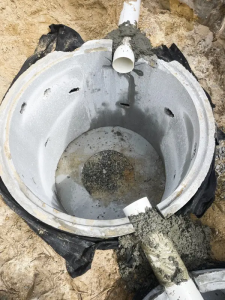Roofers Helena MT cover, repair, and replace the roofs of residential and commercial buildings. They also may apply masonry waterproofing compounds and paints. Many roofers learn their trade as helpers for experienced workers or through 3-year apprenticeship programs run by union-management committees.

Most steep-sloped roofs are covered with shingles, but roofers also lay tile, metal, and solar shingle roofs. They also install vegetative roofs, which harbor soil and plants.
Roofers are the people who keep the “roof over our heads.” They install, repair, and replace roofs on buildings to keep interiors dry and safe. They use a wide range of materials, including shingles, tiles, slates, bitumen, and metal sheets like steel, copper, or aluminum. The work requires a high level of craftsmanship and mastery of several different trades.
They begin each job by inspecting the structure of the roof and scanning it for any issues. Then they assess the needs of the client and develop a plan to address those issues. This may involve removing existing roofing material, applying new roofing materials, or installing attic ventilation systems.
Once the project starts, they follow strict safety guidelines to ensure that everyone remains safe. This includes using protective equipment, such as hard hats and safety goggles, and following all state and federal regulations regarding ladder and scaffolding usage. It also means clearing the workspace of any potential hazards, such as tripping objects or falling debris.
As they work, they follow detailed measurements to ensure that the new roofing system is the right size and shape. They also use the appropriate tools, such as power saws, shovels, hammers, nail guns, drills, and tape measures.
They may glaze top layers to make a smooth finish or embed gravel in the bitumen for rough surfaces. They may also install attic vents, such as turbine vents or gable or ridge vents. Roofers may also add skylights to a building’s roof to improve its aesthetic or reduce energy costs by letting in natural light.
Because of the high risks involved in this profession, it’s important that Roofers take every precaution to protect themselves. Before starting a job, they should remove all unnecessary items from the workspace, such as children’s toys or lawn equipment, and make sure that the ladder is secure and set up properly. They should also take extra care to wear proper footwear and gloves, especially when handling tools, as falls from heights can lead to serious injuries. In addition, they should always have another adult nearby to help them in case of an accident or emergency.
Repair
Roofers repair existing roofing materials to keep structures watertight and safe. This job requires knowledge of construction, physics, and mathematics to properly assess damage and choose the right repair methods. They often use ladders and scaffolding to access roofs, and they may also set up tarps and other protective coverings. Other duties include inspecting roofs to determine the best repair procedures and spraying materials onto surfaces to bind, seal, or insulate them.
Common repairs include repairing cracked or torn shingles, patching holes in flat roll roofing, and sealing seams and joints. Roofing professionals may also install gutter systems and trim overhanging branches to prevent debris from damaging the roof. In some cases, roofers must completely replace sections of a structure’s roofing material. They may also repair or replace flashing, which is the sheet of metal that connects roof shingles to protruding objects like chimneys and vents. This can help prevent water leaks and protect the interior of a building from mold and mildew. Finally, roofers may give clients maintenance tips to extend the life of their roofing materials.
Maintenance
The roof is a critical part of any home or business, protecting the interior and all belongings from rain, snow, hail and sunlight. As such, it needs to be installed and maintained professionally. Roofers are skilled craftsmen who install, repair and replace roofs of all types. They also maintain and inspect them. In addition, they are familiar with various materials including shingles, wood shakes, gypsum board, bitumen and metal sheets such as copper, steel and aluminum.
When installing a new roof, a roofer takes detailed measurements to calculate the amount of material needed. They also lay down layers of roofing material, including a waterproof sealant. They may also install gutters, flashing and chimney caps. In addition, they are knowledgeable about ventilation systems and insulation.
During the construction process, roofers must ensure that all roofing work is done in strict compliance with building plans and codes. They choose the substrate, roofing material and supporting accessories for each project. They are also responsible for the design of the beams, trusses and rafters that the roof is built upon.
After a roof is repaired or replaced, a professional roofer will conduct a quality inspection and clean up the work area. They will remove any debris, nails or leftover materials and make sure that the roof is secure and weatherproof. They will also clean the gutters and trim any overhanging branches or plants.
In order to perform their job well, roofers must be physically fit and comfortable working at heights for long periods of time. They must be able to use hand tools and climb on ladders or scaffolding in high places. In addition, they must be able to lift and carry heavy materials. They should also have good vision and hearing to avoid falls and other injuries.
In terms of safety, the biggest risk to a roofer is falling off of a building’s roof. Even a fall from a short, one-story house can cause head or neck injuries. Therefore, roofers must take extreme care to follow all safety guidelines and always wear a harness when climbing on a roof.
Replacement
Roofers replace the roofs of existing homes and buildings. This is a skilled trade that requires knowledge of a variety of roofing materials, as well as an understanding of building codes and the ability to analyze construction plans. Often, roofers are also responsible for tearing down old roofing material and disposing of it properly. This is a physically demanding job that involves standing on ladders and scaffolding for long periods of time. Consequently, it is not a good fit for people who are afraid of heights or those who are out of shape.
In addition to replacing shingles, roofers may also add new vents for improved attic ventilation or install ice and water sheathing in places where there is already moisture present. Likewise, they may also replace chimney flashing, wood stove pipes, roof valley flashing, and the flashing around certain vents.
In preparation for roof replacement, it is important to remove any items from the walls that are not secured to the studs. Vibrations from hammering on the roof can cause these items to fall off and become damaged. Additionally, it is a good idea to move any items that are in the way of the roofers’ work area such as patio furniture, grills, children’s toys, or potted plants.








